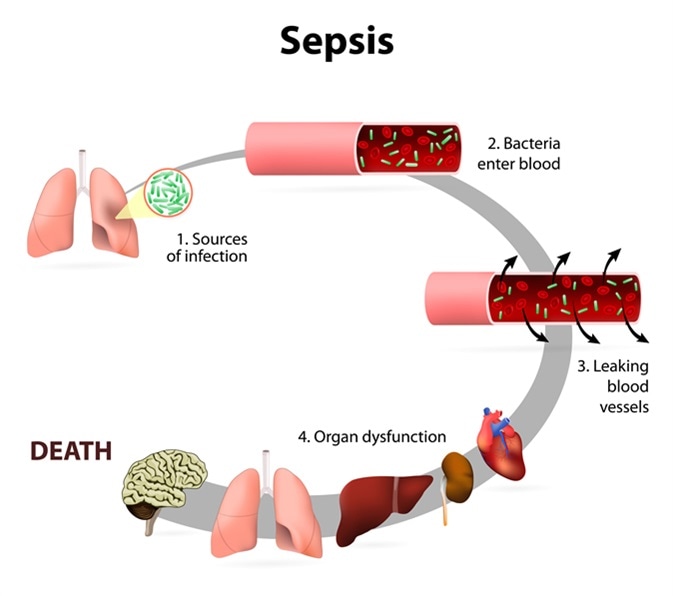Sepsis can kill a dog within a matter of hours to a few days. Sepsis, a life-threatening condition caused by a severe infection, can progress rapidly and quickly lead to organ failure and death in dogs.
In dogs, sepsis occurs when harmful bacteria enter the bloodstream and spread throughout the body, triggering an overwhelming inflammatory response. Common causes of sepsis in dogs include infections in wounds, urinary tract, lungs, or abdomen. The severity of sepsis can vary depending on the dog’s overall health, the type of infection, and how quickly it is diagnosed and treated.
Early recognition and prompt veterinary intervention are crucial in improving a dog’s survival chances. Symptoms of sepsis in dogs may include fever, rapid breathing, increased heart rate, lethargy, loss of appetite, and pale gums. If you suspect your dog has sepsis, contact your veterinarian immediately for proper diagnosis and treatment.
Understanding Sepsis In Dogs
Sepsis in dogs can be a life-threatening condition, but the time it takes to kill a dog varies. Timely recognition and immediate veterinary intervention are crucial for positive outcomes. The severity of the infection, overall health of the dog, and prompt treatment influence the survival rate.
Sepsis is a serious condition that can be life-threatening for dogs if not recognized and treated promptly. It occurs when the body’s response to an infection becomes dysfunctional, leading to widespread inflammation and organ damage. Understanding sepsis in dogs is crucial for pet owners to be able to identify the signs early on and take immediate action to save their furry friend’s life.What Is Sepsis?
Sepsis, also known as septicemia, is a condition where the body’s immune system overreacts to an infection, resulting in a harmful inflammatory response. When a dog suffers an infection, the immune system usually fights off the invading bacteria or virus effectively. However, in some cases, the immune response can become uncontrolled, causing a widespread release of inflammatory chemicals throughout the body. This can lead to damage to vital organs such as the heart, liver, and kidneys, ultimately resulting in organ failure and death if left untreated.Causes Of Sepsis In Dogs
Sepsis in dogs can be caused by a wide range of infections, both internal and external. Common sources of infection include wounds from bites, abscesses, urinary tract infections, pneumonia, and gastrointestinal infections. Additionally, dental infections, contaminated surgical sites, and even infected reproductive organs can also lead to sepsis in dogs. It is important for pet owners to seek veterinary attention as soon as they suspect any infection in their dog, as prompt treatment can prevent the development of sepsis.Signs And Symptoms Of Sepsis In Dogs
Detecting sepsis in dogs can be challenging as the symptoms can vary depending on the severity of the infection and the organs affected. However, there are some warning signs that pet owners should be aware of. These may include:- Severe lethargy or weakness
- Loss of appetite
- Rapid, shallow breathing
- Elevated heart rate
- Fever or hypothermia
- Unusual bleeding or bruising
- Yellowing of the skin or eyes (jaundice)
- Vomiting or diarrhea

Credit: www.news-medical.net
Factors Affecting The Timeline Of Sepsis Progression
Sepsis progression in dogs can vary depending on factors such as the severity of infection, the dog’s overall health, and promptness of treatment. Quick recognition and intervention can significantly impact the timeline of sepsis progression and may increase the chances of survival.
When it comes to sepsis in dogs, the timeline of progression can vary depending on several factors. Understanding these factors can help pet owners recognize the severity of the infection and take appropriate actions. The following are three key factors that play a crucial role in determining how quickly sepsis progresses in dogs:Severity Of The Infection
The severity of the infection is a critical factor in determining how quickly sepsis can progress in dogs. Sepsis occurs when the body’s immune response to an infection becomes dysregulated, leading to widespread inflammation and potential organ damage. In mild cases, the body may be able to control the infection and prevent it from progressing to sepsis. However, in severe cases where the infection is more aggressive or resistant to treatment, sepsis can develop rapidly. Detecting the severity of the infection early on is crucial in managing and treating sepsis effectively.Underlying Health Conditions
Underlying health conditions can significantly impact the timeline of sepsis progression in dogs. Dogs with pre-existing health issues such as weakened immune systems, chronic diseases, or previous organ damage may be more susceptible to developing sepsis. These underlying conditions can compromise the body’s ability to fight infections effectively and can lead to a quicker progression of sepsis. It is important to note any existing health conditions when assessing the potential risk of sepsis in dogs.Treatment And Early Detection
Early detection and prompt treatment are crucial in managing sepsis and potentially slowing down its progression. When sepsis is caught and diagnosed early, the chances of successful treatment and recovery increase significantly. Effective treatment strategies may include administering intravenous fluids, antibiotics, and providing supportive care to stabilize the dog’s condition. Additionally, monitoring for any signs or symptoms of sepsis, such as fever, increased heart rate, respiratory distress, or lethargy, can aid in early detection and intervention.In conclusion, several factors influence the timeline of sepsis progression in dogs. The severity of the infection, underlying health conditions, and timely treatment and detection all play crucial roles in determining how quickly sepsis can become life-threatening. As responsible pet owners, being aware of these factors and understanding the importance of early intervention can potentially save a dog’s life.The Lethal Timeline: How Long Does Sepsis Take To Kill A Dog?
Sepsis can be fatal for dogs, but the timeline varies. It’s essential to recognize the signs early and seek immediate veterinary care to increase the chances of survival.
Variances In Sepsis Progression
Sepsis, a life-threatening condition caused by the body’s overwhelming response to infection, can progress at different rates in dogs depending on various factors. The duration from onset to fatality may vary based on the dog’s overall health, the type and severity of infection, and the promptness and effectiveness of treatment.Average Timeframe For Sepsis Fatality
While sepsis can progress rapidly and be fatal within a matter of hours, the typical average timeframe for sepsis to cause death in a dog is around 48 to 72 hours from the onset of symptoms. It is important to note, however, that each case is unique, and some dogs may experience a more accelerated or prolonged progression.Factors That May Expedite Or Delay The Lethal Timeline
Several factors can influence the pace at which sepsis progresses and ultimately leads to fatality in dogs. These factors include:- The underlying cause of infection: The type, location, and severity of the infection can impact how quickly sepsis develops and spreads throughout the body. Infections originating from the urinary tract, respiratory system, or wounds are especially prone to triggering sepsis.
- The dog’s immune system: A dog with a weakened or compromised immune system may be more susceptible to a rapid onset of sepsis. Conversely, a robust immune response can potentially slow down the progression of sepsis.
- Timeliness of intervention: Early recognition and prompt initiation of appropriate treatment can effectively combat sepsis and potentially delay its lethal progression. Quick action by pet owners and veterinary professionals can make a significant difference in the outcome.
- General health and age of the dog: Dogs with underlying health conditions or advanced age may be at higher risk of sepsis and more prone to a rapid deterioration in their health.

Credit: www.amazon.com

Credit: www.umc.edu
Frequently Asked Questions Of How Long Does Sepsis Take To Kill A Dog
How Long Before A Dog Dies From Sepsis?
A dog with sepsis can die within a few days to a few weeks, depending on the severity of the infection and the dog’s overall health. Swift treatment is essential to improve the dog’s chances of survival. Monitoring symptoms and seeking veterinary care immediately is crucial.
What Are The Final Stages Of Sepsis Before Death?
The final stages of sepsis before death vary, but common signs include organ failure, low blood pressure, confusion, difficulty breathing, and decreased urine output.
How Quickly Can Sepsis Kill?
Sepsis can kill quickly. It is a life-threatening condition that can lead to organ failure and death within hours or days. Immediate medical attention is crucial to increase chances of survival.
What Does Sepsis Look Like In A Dog?
Sepsis in dogs appears as fever, rapid breathing, and increased heart rate. Other signs can include weakness, lethargy, loss of appetite, and pale gums. Immediate veterinary attention is crucial in order to diagnose and treat sepsis effectively.
Conclusion
Recognizing the signs of sepsis in dogs is crucial, as the condition can progress rapidly and be fatal if left untreated. Being proactive in seeking veterinary care, maintaining your dog’s overall health and hygiene, and promptly addressing any infections can greatly reduce the risk of sepsis.
Remember, early detection, timely intervention, and expert veterinary care are paramount in saving your furry friend from the devastating effects of sepsis.



